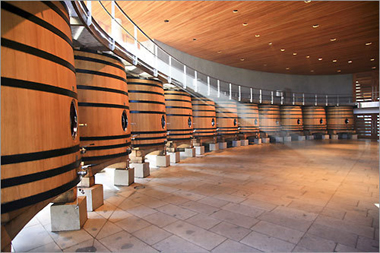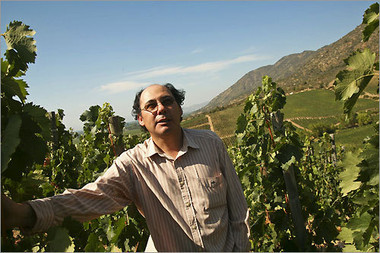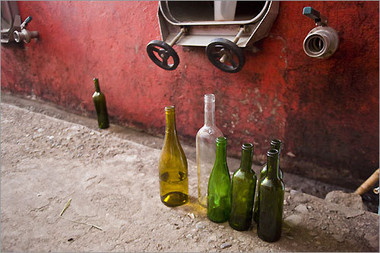Chile from vine to vat
April 6, 2008 - The Boston Globe - Travel

From vine to vat, trying new ways to raise the bar
Click here to see my full photo shoot that ran with the story
CENTRAL VALLEY, Chile—In a dirt hole with what appears to be a tarantula, I inspect the root structure of wine vines through a plexiglass pane while Jorge Castillo holds the trap door open and laughs. “Don’t worry,” he says, “It’s just a chicken spider!” I suppress visions from “Indiana Jones and The Temple of Doom” and back away calmly.
Who knew that a greater understanding of Chilean wine involved sitting in a hole with a furry, saucer-sized arachnid?
Wines produced on this side of the Andes tend to be reliable at a good price, but they rarely knock your socks off. As one winemaker here says, “Chilean wines are like a Volvo.”
Despite centuries of growing experience, Chilean wines are historically a bulk product. When wine consumption dropped some years back, many farmers in the Colchagua Valley simply ripped up their vines and planted kiwis and apples. This quicker buck and a “wine by the kilo” mentality trumped any commitment to growing the old vines that make the best wines.
That said, a growing number of winemakers are leaving their comfort zone to forge anew the identity of Chilean wines. The Andes rise sharp, snow-capped, and spiky to the west and the Coastal Range protects the valley to the east. The two mountain chains create a largely predictable climate known for hot days and cool nights - idyllic wine country.
 Agriculture manager Jorge Castillo out among the vines at Casa Lapostolle in Chile’s Colchagua Valley. The winery is in the process of a complete changeover to making biodynamic wine - a strict version of organic production. (Joe Ray for The Boston Globe)
Agriculture manager Jorge Castillo out among the vines at Casa Lapostolle in Chile’s Colchagua Valley. The winery is in the process of a complete changeover to making biodynamic wine - a strict version of organic production. (Joe Ray for The Boston Globe)Castillo, the agriculture manager at Casa Lapostolle winery, is unfazed by the “What’s Chilean?” question. “You can make good wine around the world, but there are many roads to Rome,” he says.
Castillo’s road has chicken spiders; he believes they’re part of growing good grapes. “The farm is an organism,” he says. “The work is done by the animals in the hills. If you fertilize or use pesticides, you do it to the whole organism and the people who work there.”
Lapostolle is in the middle of the years-long process of going biodynamic: organic farming with practices like using quartz powder buried inside a cow horn as a pesticide and other practices that are often laughed at by industrial farmers and winemakers.
“I didn’t think it would work; it took me two years to believe,” Castillo explains as we bang through the fields in his truck.
Among the vines, we pass vegetable gardens that provide diversity for the farm and food for the winery’s small restaurant. Sections of steep vines are maintained by using horses instead of ground-crushing tractors, and there’s an 18-wheeler-sized hump of rich soil used for growing two kinds of earthworms that aerate and fertilize the soil.
Castillo stops to look at some vines with a few tiny red bugs on the leaves, which he examines by pulling a tiny magnifying glass from his pocket.
“You treat it [with pesticides] and they die off for a bit, but the same chemical used to kill the bugs kills its predators. But if you don’t use it, the equilibrium restores itself,” he says. “The pesticide vendor comes around every couple weeks to see if we’ve cracked, but I just smile and wave him off.”
While their approach is green, it isn’t 100 percent local. Casa Lapostolle uses the outside expertise of consultant Michel Rolland. A “flying winemaker,” Rolland was roasted in the documentary film “Mondovino” for zipping around the world, homogenizing wines and making important decisions for his wineries in the space of a couple of days. What’s Chilean about that?
“When you see a Chanel dress, it’s not like Coco sewed it,” counters Andrea Léon, oenologist for Casa Lapostolle’s high-end Clos Apalta label. Léon gives me a wine blending primer.
We start by tasting a merlot and a carmenère, Chile’s signature grape. The merlot has a strong berry smell but a flavor that vanishes quickly. The carmenère seems locked inside its tannins; alone, this wine would need some aging before it’s ready to drink.
Léon creates a 50-50 blend in a beaker and pours it into a wine glass. I imagine each grape helping the other to create something better than either of them alone.
 Winemaker Sergio Silva’s production is so small, he uses his Santiago hardwood supply store as an ad-hoc distributor. (Joe Ray for The Boston Globe)
Winemaker Sergio Silva’s production is so small, he uses his Santiago hardwood supply store as an ad-hoc distributor. (Joe Ray for The Boston Globe)“Blech!” proclaims Léon after one sip.
None of the positive qualities from either grape have made it into the glass. “Sometimes, one plus one is not better,” she says.
She tries 75-25 mixtures. The merlot blend picks up some of the nuances of both wines while the carmenère-heavy blend has a flat smell, good flavor, and serious potential down the line.
“Sometimes, you’re blending for something immediate, sometimes, it’s for two or three years from now,” she says. “It helps if you think about what you’re working toward.”
Something nice to have with lunch seems a noble goal, so we steer toward the merlot mix.
Lips and tongue purple, Léon forges ahead, pulling out a pipette. “Change just 1 percent and the difference can be unbelievable.” The berry smells and flavors build, the chocolate and coffee flavors stretch through a long aftertaste. Eventually, we end up with a 72-18 blend.
Farther south at Gillmore Winery & Vineyards in the Maule Valley, it’s another world, a hot and intensely dry climate with golden hills reminiscent of California wine country. Here, the vineyards are refreshingly forward-thinking, an attitude apparent in the fantastic complexity of some Maule Valley wines.
Andrés Sánchez, Gillmore winemaker and former Kendall-Jackson consultant, gives me an impromptu lesson on the importance of acidity in wine.
“A high pH [low acid] wine gives you instant satisfaction. It’s like Pamela Anderson,” he says. But over time, the fruits drop, the oak-barrel flavors get too big, and the complexity that you’d expect from a great wine never develops.
“Chilean wines try to copy a model that doesn’t work,” he says, adding to his idea that Chilean wines are like Volvos. “People are heading places to stress the wines more, but that’s not enough, you need your own vision.”
“A low pH is a longer and more complex burn,” adds Sánchez. “It’s like Isabella Rossellini.”
His lab, a former bulk wine vat made of cement, is one of the least idyllic settings imaginable for tasting wine. We taste several excellent ones, including a cabernet that’s one of the best Chilean wines I’ve had.
 Andrés Sánchez, winemaker at Gillmore Winery & Vineyards in Chile’s Maule Valley, takes a break. “Chilean wines try to copy a model that doesn’t work,” he says, adding to his idea that Chilean wines are like Volvos. “People are heading places to stress the wines more, but that’s not enough, you need your own vision.” (Joe Ray for The Boston Globe)
Andrés Sánchez, winemaker at Gillmore Winery & Vineyards in Chile’s Maule Valley, takes a break. “Chilean wines try to copy a model that doesn’t work,” he says, adding to his idea that Chilean wines are like Volvos. “People are heading places to stress the wines more, but that’s not enough, you need your own vision.” (Joe Ray for The Boston Globe)Excellent garage wine turns up with an unlikely producer. I find Sergio Silva sipping strawberry juice in the backyard of his Curicó Valley summer home at Santa Hortensia vineyard.
Silva bought the vineyard as a fixer-upper vacation home in 1991, not caring much for winemaking and letting the neighbor run his 75 acres of vines in exchange for use of his tiny winemaking bodega.
“The money I made from the wine [sold in bulk] paid for the whole property, but it was awful,” he says, “It was like that for years, but in 1997, the neighbor sold and gave me the keys back.”
He modernized his facilities and started making some good stuff on the side. Silva now sells micro productions of seven kinds of bottled wine to local restaurants and distributes it out of his Santiago hardwood supply store.
We have a glass of the chardonnay, which has picked up a pair of local awards in its first year of production. Though it’s not knock-your-socks-off stuff, it’s good wine.
I ask about the Santa Hortensia name and Silva grins.
“Hortensia was my mom’s name,” he says with a dose of Chilean sentimentality.
“And Santa?” I say.
“To me, she’s a saint.”
Joe Ray, a freelance writer and photographer, can be reached through his website, joe-ray.com.
If you go…
What to do
Valle del Maule Ruta del Vino
Talca
011-56-71-246460; valledelmaule.cl
The visitors center located in the beautiful Villa Cultural Huiquilemu can be a great help to set up visits to Maule Valley wineries.
Casa Lapostolle/Clos Apalta
Santa Cruz
011-56-72-321803; casalapostolle.com
Tour and tasting $40. Private guest houses for two with breakfast tour and tasting $500 November through April, $400 for the rest of the year (closed June 15-Sept. 14). Meals with wine around $100 per person and up.
Gillmore Winery & Vineyards
San Javier
011-56-73-197-5539; gillmore.cl
Some of the best wines coming out of Chile are from this family-run winery.
Santa Hortensia Winery
Curicó
011-56-75-328-972; santahortensia.cl
(Spanish only)
An accidental garage wine made for all the right reasons.
Where to stay
Hotel Santa Cruz Plaza
Plaza de Armas, 286 Santa Cruz
011-56-72-209-600; hotelsantacruzplaza.cl
Reserve online at a discount; doubles start at $212. The hotel’s restaurant, Los Varietales, has one of the best reputations around. A la carte is about $35 per person. During the week, a prix-fixe menu is about $22.
Hotel Colonial Maule
Cancha de Carerras Villa Alegre
011-56-73-381-214; hotelcolonialmaule.com
(Spanish only)
Room for two near Gillmore Winery with double bed and breakfast, about $60.
See the .pdf version of this story as it ran in the Boston Globe : page 1,page 2